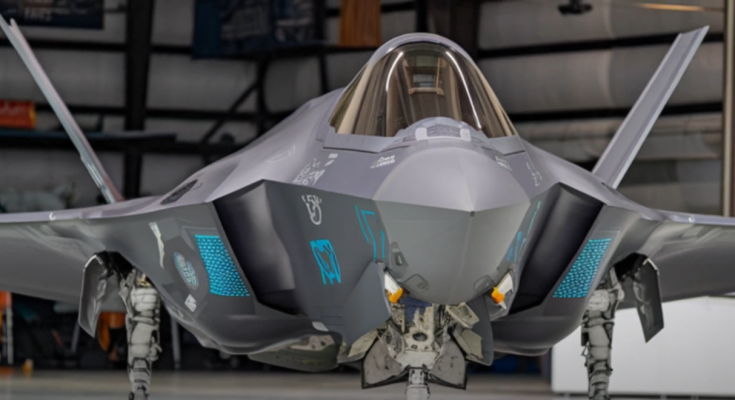The F-35A Lightning II, developed by Lockheed Martin, stands as one of the most advanced and versatile fighter jets in the world. With continuous upgrades and innovations, the 2025 version of the F-35A is arguably the most powerful and capable fighter aircraft on Earth. Its combination of cutting-edge stealth technology, sensor systems, versatility, and multi-role capabilities positions it as a game-changer in modern air combat. This multi-role fighter jet is not just a tool of air superiority but also serves as a cornerstone for strategic defense, ensuring the U.S. and its allies maintain a distinct edge in global military operations.
Stealth Technology: Invisibility in the Sky
One of the most significant features of the F-35A is its stealth capabilities, which make it almost invisible to enemy radar. The aircraft’s design incorporates advanced materials and a shape that minimizes its radar cross-section, enabling it to avoid detection and deliver surprise strikes on adversaries. Unlike many traditional fighter jets, the F-35A can operate in heavily contested environments with integrated radar and missile systems that would normally be a significant threat to older platforms. Its stealth technology makes it a perfect choice for high-risk missions where evading enemy detection is critical.
Furthermore, the low-observable technology is complemented by electronic warfare (EW) systems, which can jam or deceive enemy radars, making the aircraft even more difficult to track. These capabilities allow the F-35A to engage targets without alerting adversaries, ensuring tactical superiority and survivability in complex combat situations.
Advanced Avionics and Sensor Fusion
The F-35A is equipped with the most advanced avionics and sensor systems, providing unparalleled situational awareness. At the heart of its systems is the Distributed Aperture System (DAS), which integrates infrared sensors that give pilots a 360-degree view of the battle space. This system can detect and track aircraft, missiles, and other threats from far distances, even in low-visibility conditions. The aircraft’s Active Electronically Scanned Array (AESA) radar offers high-resolution tracking capabilities, allowing pilots to monitor and engage multiple targets at once.
The F-35A also utilizes sensor fusion technology, which integrates data from multiple sources, such as radar, infrared sensors, and electronic warfare systems. The processed information is displayed on the pilot’s heads-up display (HUD), creating a seamless and coherent operational picture. This gives the pilot a complete view of the battlefield, ensuring informed decision-making and the ability to engage threats with confidence.
Versatility in Combat Missions
The F-35A is a multi-role fighter, designed to perform a wide array of combat missions with unmatched flexibility. Whether it’s air-to-air combat, precision strikes on the ground, or intelligence, surveillance, and reconnaissance (ISR), the F-35A excels in all areas. It can carry a range of advanced munitions, including precision-guided bombs, air-to-air missiles, and stealthy munitions, allowing it to strike targets with deadly accuracy.
Its versatility is further enhanced by its air-to-ground and close air support capabilities, making it a key asset for ground forces in conflict zones. The F-35A’s ability to seamlessly switch between missions and adapt to changing battle conditions gives commanders a highly effective tool in modern warfare.
Performance and Agility
The F-35A boasts incredible speed, agility, and range. Powered by a Pratt & Whitney F135 engine, it can reach speeds of over Mach 1.6 and has a combat radius of approximately 1,380 miles. This range ensures that it can conduct deep-strike missions far from home bases, while its agility allows it to outmaneuver most enemy aircraft. The aircraft’s superior thrust-to-weight ratio and advanced flight controls give it the ability to perform highly dynamic maneuvers, making it an exceptional adversary in both air-to-air and air-to-ground combat.
Interoperability and Global Presence
Another key feature of the F-35A is its interoperability with NATO allies and other allied forces. The F-35A is used by several countries, including the U.S., the U.K., Israel, Japan, and Australia. This widespread adoption ensures seamless cooperation among allied forces during joint operations. The aircraft’s advanced communication and networking systems allow it to easily integrate with other military platforms, including other fighter jets, unmanned aerial vehicles (UAVs), and command-and-control systems, improving coordination on the battlefield.
Conclusion: The Ultimate Fighter Jet
The F-35A Lightning II (2025) truly earns its reputation as one of the most powerful fighter jets on Earth. Its combination of stealth, advanced sensors, multi-role capabilities, and superior performance makes it an essential asset in modern military operations. The aircraft is not only a symbol of technological innovation but also a force multiplier for the U.S. and its allies, ensuring dominance in air combat and the ability to respond rapidly to evolving global threats. As the F-35A continues to evolve, it remains at the forefront of air combat, shaping the future of warfare for decades to come.



